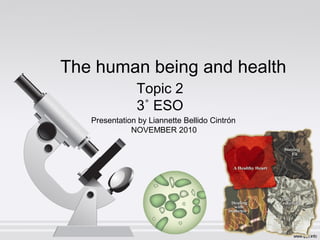
Topic 2
- 1. Topic 2 3˚ ESO The human being and health Presentation by Liannette Bellido Cintrón NOVEMBER 2010
- 2. • Health (WHO) It is the complete physical, mental and social well being, and not just the absence of illness. • Illness: Is a disorder that occurs when a part of an organism is altered and stops fulfilling its function correctly, showing characteristic symptoms. • In order to maintain good health and avoid illness, we can control the following factors: 1. A healthy environment •Free from harmful biological elements (microbes and other dangerous living things) •Free from harmful physical elements such as radiation and noise •Free from harmful chemical elements (poison and pollution) •Also free from elements that are damaging to health such as violent and aggressive atmospheres 2. Aquiring the habits and styles of a healthy life 3. Certain personal characteristics such as hereditary factors, age etc. 4. The presence or existence of an efficient health system with preventative measures or programs
- 3. • In order to maintain good health and avoid illness, we can control the following factors: 1. A healthy environment – Free from harmful biological elements (microbes and other dangerous living things – Free from harmful physical elements such as radiation and noise – Free from harmful chemical elements (poison and pollution) – Also free from elements that are damaging to health such as violent and aggressive atmospheres 2. Aquiring the habits and styles of a healthy life. 3. Certain personal characteristics such as hereditary factors, age etc. 4. The presence or existence of an efficient health system with preventive measures or programs.
- 4. Types of illness • Depending on the cause, illnesses can be: – Infectious: they are caused by pathogenic microbes. – Non-infectious: they are not caused by micro organisms. • Depending on its course: •Acute: they show up quickly and don’t last long •Chronic: they develop slowly and last a long time. • Depending on the frequency: •Sporadic: they are not very common •Endemic: they are common and exclusive to a certain region (e.g malaria) •Depending on the number of people affected: •Epidemic: the illness attacks many people in a short space of time. •Pandemic: this is when the epidemic affects many countries or even the whole planet
- 5. Infectious Diseases Microorganisms that cause infectious diseases are: Bacteria Virus Fungi Protozoa
- 7. Illness Main organs and tissues affected Measles Skin Hepatitis Liver Rabies Nervous Tissue AIDS Immune system Tuberculosis Lungs Cholera Intestines Diphtheria Upper respiratory tract Tetanus Muscles Athletes’ foot Skin Candidiasis Skin and mucus Malaria Blood Sleeping sickness Nervous Tissue Microorganisms Virus Bacteria Fungi Protozoans Examples of illnesses caused by these microbes
- 8. How infectious diseases are transmitted • Infectious disease are contagious because causing microorganisms are transmitted from an infected person to a healthy person through different ways.
- 9. • By direct contact- The microorganism goes directly from the place where it is to the receiver, without any intermediary, as it happen with measles or sexually transmitted diseases.
- 12. When the pathogens defeat the defenses of the invaded organism, an infection occurs. Phases of infectious disease: • Incubation period- The time between the start of the infection and the manifestation of the first symptoms. Its duration depends on the kind of disease. The development of an infectious disease
- 14. • An ill individual can spread the disease in any phase of his or her sickness. • There are also some individuals that do not develop the symptoms of a disease but can spread it. The infectious disease
- 15. The organism fights infection by activating two systems of defenses: • External defenses – This is the first line of defense of the organism. It includes structural, mechanical, biochemical, and ecological defenses. These defenses can work together. Example: the skin The defense of the organism against infection
- 16. Structural defenses, such as the skin and mucose membranes. Biochemical defenses, such as saliva, tear drops and gastrci juices. Mechanical defenses that drag foreign particles from the body Ecological defenses, such as E. coli, a bacteria that humans have in their stomach.
- 17. • Internal defenses- If the external defenses are not enough the immune system activates the leukocytes and white blood cells. These defenses are very effective and are divided between unspecific and specific.
Notas do Editor
- measles sarampión